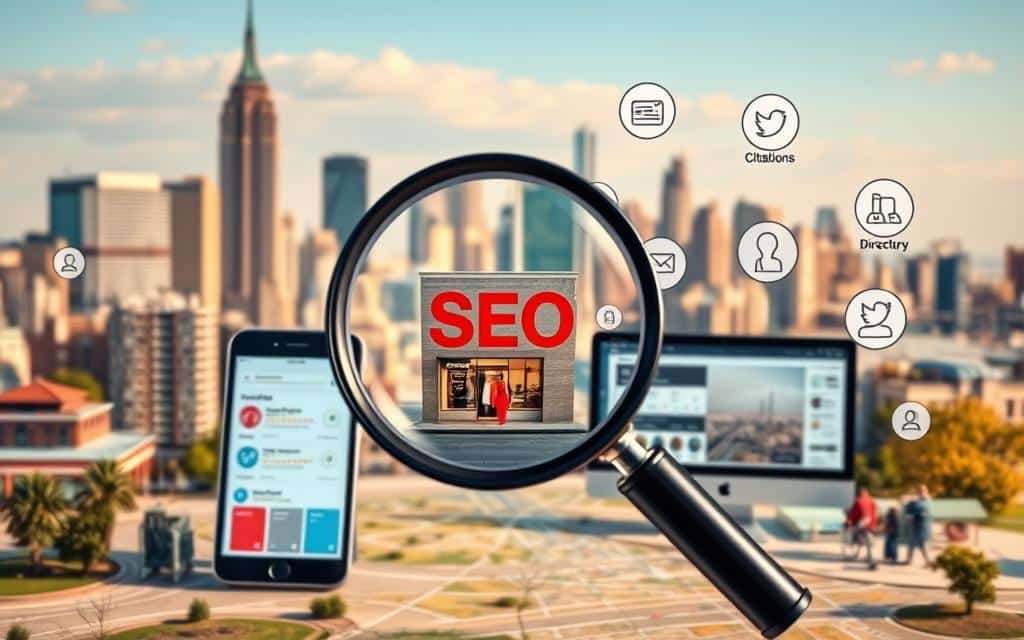You’ve put in the work, but your business still doesn’t show up when locals search for what you offer. Meanwhile, competitors dominate those precious search results, leaving you invisible to potential customers. I get it—it’s like shouting into a void. But here’s the good news: local SEO isn’t a secret club. With a clear plan, you can turn this around faster than you think.
I’ve helped dozens of brick-and-mortar businesses climb those rankings. It’s not about complicated tricks—it’s about consistent, smart steps that align with how people find services nearby. Whether you’re running a café or a cleaning service, the principles stay the same. Let’s break down what actually moves the needle.
Think of this as your playbook for building visibility where it matters most. We’ll cover why a documented strategy beats random efforts every time and how to avoid common pitfalls that keep businesses stuck. By the end, you’ll know exactly where to start—and how to measure what’s working.
Key Takeaways
- A documented local SEO strategy is essential for competing in search results
- Small businesses can achieve visibility without complex marketing tactics
- Local search optimization directly connects you with nearby customers
- Systematic processes outperform random or inconsistent efforts
- Practical steps can transform your online presence within weeks
Understanding the Local Landscape
Ever wonder why some businesses pop up first when neighbors search for solutions? It starts with knowing your backyard better than anyone else. Picture this: 20% of walk-ins discover stores through online queries. That number’s climbing faster than a kid on a jungle gym.
Who’s Knocking on Your Digital Door?
Your perfect customer isn’t just “someone nearby.” It’s the parent searching for same-day diaper delivery or the contractor needing emergency plumbing services at 2 AM. I’ve seen coffee shops triple foot traffic by focusing on remote workers craving fast Wi-Fi – not just caffeine.
Dig into neighborhood demographics like a detective. Age ranges, average incomes, even commute patterns shape what people need. Young families? Highlight stroller-friendly spaces. Retirees? Emphasize afternoon specials. These insights turn random searches into ringing doorbells.
Search Habits Are Changing – Fast
Remember when everyone typed “best pizza near me”? Now they’re asking phones: “Where can I get gluten-free pepperoni delivered before 7?” Voice searches and mobile queries grew 150% last year. People want answers before they finish the question.
Your Google Business Profile isn’t just a digital signpost anymore. It’s where customers check your holiday hours, compare prices, and read reviews – all while waiting in line elsewhere. Stay ahead by updating your profile weekly and answering questions publicly. Next section, we’ll break down exactly how to make that profile work overtime.
how to create a local SEO advertising campaign
What separates thriving businesses from those stuck in search result purgatory? It starts with knowing exactly where you’re headed. Your roadmap – let’s call it your game plan – needs clear destinations, not vague directions.

Numbers Don’t Lie – Track What Matters
I’ve seen too many owners say they want “more customers” without defining what that means. Be specific: aim for 40 extra calls monthly or 15% more weekend walk-ins. These targets become your compass.
Here’s what works:
- Revenue-driven metrics: Track keywords that convert browsers into buyers
- Time-bound checkpoints: Weekly review of website traffic sources
- Localized benchmarks: Compare your growth to similar area businesses
Set 90-day milestones and annual visions. Last month, a bike shop owner discovered 68% of their sales came from three neighborhood-specific phrases. They doubled down – now those terms dominate their search presence.
Your strategy evolves as you learn. Update it quarterly using real data, not guesses. Those initial hours spent planning? They’ll save you months of wandering aimlessly later.
Building a Strong Local SEO Strategy
Local visibility isn’t a lottery—it’s a science you can master with the right data. Start by analyzing where you stand today. Tools like Google Search Console and SEMrush reveal what phrases neighbors actually use to find services like yours. One bakery owner I worked with discovered 80% of their traffic came from “fresh croissants [City Name]” searches—they optimized accordingly and tripled foot traffic in three months.

Mapping out a data-driven plan
Your first move? Identify high-value keywords with local intent. Phrases like “emergency pressure washing services” or “dog groomer near downtown” attract ready-to-buy customers. Compare your site’s performance against competitors using metrics like organic click-through rates and backlink quality.
| Tool Type | Free Options | Paid Solutions |
|---|---|---|
| Keyword Research | Google Keyword Planner | Ahrefs, Moz Pro |
| Site Audits | Google Search Console | Screaming Frog |
| Rank Tracking | Google My Business Insights | BrightLocal |
Incorporating local best practices for visibility
Optimize your Google Business Profile with photos updated weekly and detailed service descriptions. Build citations on directories like Yelp and Apple Maps—consistency matters here. Encourage reviews by texting customers a direct link after appointments. A hardware store increased reviews by 300% using this tactic, boosting their map pack rankings.
Create neighborhood-specific content that answers real questions. Think “How to prepare pipes for Boston winters” or “Best patio plants for Midwest summers.” This approach positions you as the go-to expert while aligning with local search patterns.
Optimizing Your Google Business Profile
Your storefront isn’t just physical anymore – it’s digital, and it’s open 24/7. I’ve watched businesses jump 3 spots in search results simply by polishing their online presence. Let’s fix what most owners overlook.
First Impressions Last Forever
Outdated info scares customers away faster than a “Closed” sign. Check your profile’s name, address, and phone number – they must match your website exactly. One restaurant lost reservations for months because their Google listing showed an old menu price.
Photos tell your story better than any sales pitch. Upload shots of your team in action, popular products, and your building’s exterior. A flower shop gained 22% more inquiries after adding weekly behind-the-scenes photos. Rotate images monthly to stay fresh in searches.
Conversations Build Trust
Reviews are modern word-of-mouth. Respond to every comment within 48 hours – even negative ones. A simple “Let’s fix this together” shows you care. Answer Q&A questions proactively. One hardware store reduced phone calls by 40% by pre-answering FAQs about parking and pet policies.
| Profile Element | Impact | Action Frequency |
|---|---|---|
| Business Information | 35% ranking boost | Monthly audit |
| Customer Photos | 2x profile clicks | Weekly updates |
| Review Responses | 18% conversion lift | Within 2 days |
Consistency matters everywhere. Sync your profile’s hours with social media posts and website notices. Conflicting info confuses customers and search algorithms alike. Set calendar reminders to refresh content quarterly – it takes 15 minutes but keeps your profile relevant.
Conducting Competitor Research for Local Success
Ever peek at the diner across town dominating weekend brunch searches? Their secret sauce might be simpler than you think. Local rivals ranking above you aren’t magicians—they’re just executing fundamentals better. I’ve reverse-engineered dozens of successful profiles, and here’s what matters most.
Analyzing Competitor SEO Activities
Start by checking their Google Business Profile. Are service pages packed with neighborhood keywords like “vintage bike repair [City]”? Do their website titles mention specific areas? Tools like Ubersuggest help uncover their top-performing phrases.
Look for patterns: consistent blog posts about local events, backlinks from community websites, or detailed service descriptions. One auto shop I analyzed gained traction by listing every nearby ZIP code they serve—a tactic their competitors overlooked.
Spotting Opportunities in Content and Engagement
Notice what’s missing. Are rivals ignoring FAQs about parking or pet policies? Do their customer reviews go unanswered for weeks? These gaps become your openings.
Prioritize low-hanging fruit first: outdated photos on competitor profiles, broken local directory links, or unclaimed listings on niche sites like Nextdoor. One bakery noticed competitors ignored gluten-free options in their blog posts—they filled that gap and climbed 4 spots in two months.
Remember: this isn’t about copying. It’s about learning what works locally, then doing it better. Track changes monthly—your advantage grows when others stay complacent.
